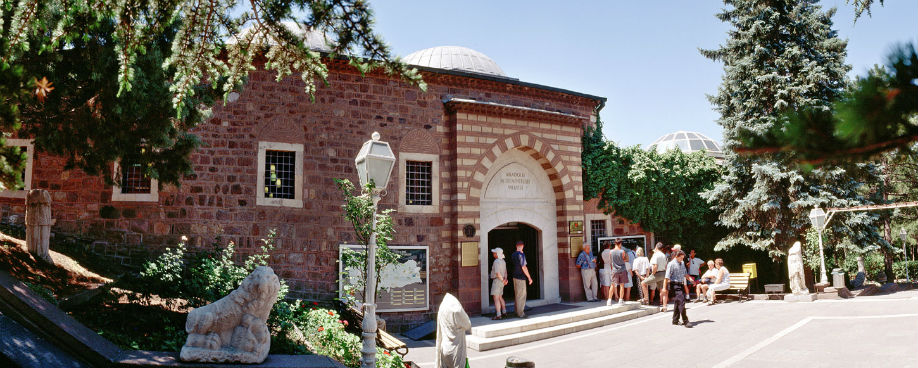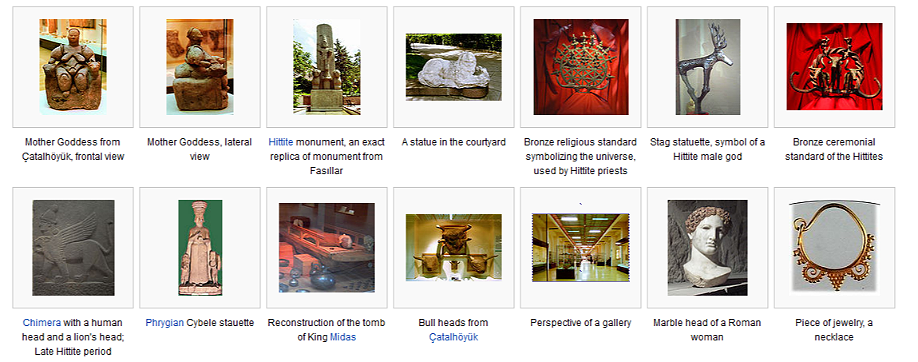The superb Museum of Anatolian Civilisations is the perfect introduction to the complex weave of Turkey’s ancient past, housing artefacts cherry-picked from just about every significant archaeological site in Anatolia.
The museum is housed in a beautifully restored 15th-century bedesten (covered market). The 10-domed central marketplace houses reliefs and statues, while the surrounding hall displays exhibits from the earlier Anatolian civilisations: Palaeolithic, Neolithic, Chalcolithic, Bronze Age, Assyrian, Hittite, Phrygian, Urartian and Lydian. The downstairs sections hold classical Greek and Roman artefacts and a display on Ankara’s history. Get there early to avoid the flood of tour groups and school parties.
The exhibits are chronologically arranged in a spiral: start at the Palaeolithic and Neolithic displays in the room to the right of the entrance, then continue in an anticlockwise direction, visiting the central room last.
Items from one of the most important Neolithic sites in the world Çatalhöyük, southeast of Konya – are displayed here. There’s a mock-up of the inside of a dwelling typical of those uncovered at the site, one of the most famous mother goddess sculptures unearthed from the excavations and wall paintings of hunting scenes.
Also on show are many finds from the Assyrian trading colony Kültepe, one of the world’s oldest and wealthiest bazaars. These include baked-clay tablets found at the site, which dates to the beginning of the 2nd millenium BC.
One of the striking Hittite figures of bulls and stags in the next room used to be the emblem of Ankara. The Hittites were known for their relief work, and some mighty slabs representing the best pieces found in the country, generally from around Hattuşa, are on display in the museum’s central room.
Most of the finds from the Phrygian capital Gordion, including incredible inlaid wooden furniture, are on display in the museum’s last rooms. The exhibits also include limestone blocks with still-indecipherable inscriptions resembling the Greek alphabet, and lion- and ram-head ritual vessels that show the high quality of Phrygian metalwork.
Urartian artifacts are also on display here. Spurred by rich metal deposits, the Urartians were Anatolia’s foremost metalworkers, as the knives, horse-bit, votive plates and shields on display demonstrate. There are also terracotta figures of gods in human form, some revealing their divine powers by growing scorpion tails, and neo-Hittite artefacts.
Downstairs, classical-period finds and regional history displays provide a local picture. Excavations have unearthed a Roman road near the Column of Julian, and Ankara has its own ‘missing link’, the 9.8-million-year-old Ankarapithecus (a 30kg, fruit-eating primate).




I am so much amazed with the materials presented in this museum. It is mainly composed of anatolian civilizations starting from paleolithic age. Everything is presented in a chronological order, well preserved and nicely interpreted.
Catalogs of the museum is not very impressive, better bringing a camera and taking photos yourself.
Very important and nice mueum not in TURKEY in the world too! Very import unique items you see not anywhere else in the world about human history and development !
This is a riveting museum for anyone with a little taste for history or prehistory–or for beautiful gold objects. Enchanting displays that tell a fascinating story about ancient civilizations, including several mentioned in the old testament and visited by Alexander the Great. Good stuff most of us didn't get in school, I'm afraid, but fun to catch up with now.
Everything is written in Turkish and English. There is a beautiful map outside and lots of places to sit outside.
… then go. Take about two hours and enjoy how Turkey came together with its arts and artifacts.
Well the museum is under restructure, so not quite big for a museum. You see the beggining of civilization, from Hittites and Phrygians, Mother Goddess and first communities. Nice experience.
I visited this museum 7 years ago and had good memories, hence the return trip. This time it was a real let down. Most of it is shut for renovation – granted, this is inevitable in any museum or historic building. But here 3 out of the 5 rooms were shut, hence very little was to be seen. And yet…
Only 2 of the 5 exhibit rooms are open. It is definitely worth a visit with a confusing audio guide at reduced rates.
The big portion of the museum was closed off for remodeling.
This is a wonderful museum with unique objects from excavations of ancient sites in Turkey, particularly Hittite and earlier. Unfortunately, most of it is under restoration in 2013 and visitors only get to see one room. It is one of the recommended sites in Ankara but prepare to be a bit disappointed.